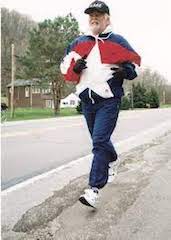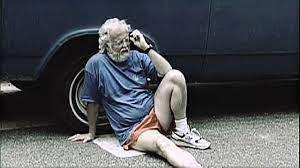Nothing is Impossible!
Terry and Sue Hitchcock met in college and they married shortly thereafter. They enjoyed the classic American Dream. Living in suburban Minneapolis, Terry worked as an executive and Sue stayed home to manage the household. By their mid-forties, they were happy, in love, and busy raising three children.
Then the unthinkable happened. Sue received a diagnosis of breast cancer. Sadly, the spread of the cancer was aggressive and her treatment was unsuccessful. Sue passed away mere months after her diagnosis.
After Sue died, Terry was thrust into single parenthood—cooking, clothing, and caring for his three young kids. Three days later, Terry lost his job and income.
Times were tough. And Terry’s eyes were opened to the plight of single parents. Finally, twelve years after Sue’s passing, he had to do something.
It was 1996, and at age fifty-seven, Terry didn’t recognize the old man in the mirror anymore. His fire was gone.
He wasn’t what you’d call athletic. But he used to challenge himself by entering the local 5K every year. He always came in last. And six months after having a heart attack, and never having run more than this annual 5K, Terry Hitchcock made a decision that would change his life forever.
He got the idea from a Canadian man—Terry Fox, a man who lost his leg to cancer and did something extraordinary in 1980.
This young nineteen-year old decided that what he was going to do was to attempt to run from east to west, across Canada, to raise money for cancer research. After one hundred forty-three days of running, and almost thirty-five hundred miles across Canada (24.5 miles a day), Terry had to leave the highway because the cancer that had taken his leg was now in his lungs. Throughout his run, he raised over twenty-four million dollars to combat cancer. Terry passed away some eight months later. To date, his foundation has raised close to one billion dollars for cancer research.
Inspired by Terry Fox, Terry Hitchcock decided to honor Sue and shine a light on the struggles that thirty-five million American single parents and their children experience. Hitchcock decided to run again. He wasn’t going to go on just any run. He wanted to go on a two-thousand-mile odyssey from St. Paul to the Olympic Games in Atlanta![i]
Terry commented, “I knew that the Olympics were going to be held in Atlanta and two of my three children were born there. The Olympics represent going beyond and doing the impossible. I thought, ‘Well maybe what I could do is run toward Atlanta and maybe do the equivalent of at least a marathon a day. I think I’ll run to the opening ceremonies of the Olympics.’ Since I’m a dreamer, I could tell the story of what I’m doing and help raise awareness for single parents and their children.”
“No runner that I ever met said that I could do this,” Terry said. “They would say it was humanly impossible. Every doctor said, ‘You just can’t do this,’ because while I was training, I had a heart attack halfway through. My cardiologist said, ‘Don’t do this. You won’t live to tell your story.’ So all those things were against me, but I just felt with my own faith that this was something I should do—that when I completed it, it’s a story for the ages.’”
Despite the odds, Terry hit the streets running with a small team of friends and family. Soon enough he realized just how difficult the journey would be.
His plan was to run slowly, but for a long time, about eight hours a day. Yet when he finally set off he wasn’t prepared for the pain-filled realities of running the road.
Terry reported, “First of all, the pounding that you put your body through is incredible. Halfway down to Atlanta, both my ankles were fractured and my left kneecap also had a fracture. I was in pain every day and just had to learn to bear it and run above it.”
He thought about quitting each and every day. “Actually, it was probably many times during a day. It was very hard.” And it only got harder as I ran farther south into warmer temperatures. “
Worst yet, after thirty days of running, his team began to disband. “Five of the six said, ‘We’re going to go home,’ because it wasn’t fun. It was very hard work. They were young and they missed their friends. The thirty-first day I’m standing on the side of the road with a trailer going home, and beside me is my oldest son Christian. He is looking at me saying, ‘Dad, I’m not going to leave you.’ It seemed like Chris and I against the world.”
“Crossing the finish line at Centennial Park in Atlanta, knowing that I had just finished almost twenty-one hundred miles—and I was still alive—that made it all worth it.”
Terry’s run required running slightly over a marathon a day for seventy-five days—an average of twenty-eight miles per day.
It has shown me, in no uncertain terms, that I am here on this earth to ‘teach,’ to show others that their ‘daily marathons’ are possible to get through each day, that nothing is really impossible, that one’s own personal faith is the strength we all need to help run our marathons, and that I am simply a vehicle to make a difference for others.
Terry Hitchcock’s purpose is this: I am here on this earth to show others that their daily marathons are possible to get through each day and that nothing is really impossible.
Years after his run, the late producer and director Tim Vandesteeg completed a documentary called My Run, narrated by Academy Award winner Billy Bob Thornton. My Run won 10 awards. Hitchcock also wrote a book telling his story, A Father’s Odyssey.[ii]
The story of Terry Hitchcock is more than a story about a man running multiple marathons; it’s about the daily marathons every one of us runs.
When you’re faced with obstacles, you have a choice.
If a fifty-seven-year-old man with no athletic ability can run a marathon a day for seventy-five consecutive days, then just imagine what you can do!
You can give up or you can keep pushing. It’s your decision.
As Terry Hitchcock shows, “Nothing is impossible.”
[i] “The Man Who Ran to Atlanta,” Euan Kerr, MPR News, April 16, 2010 https://www.mprnews.org/story/2010/04/16/my-run.
[ii] “My Run Q&A with Terry Hitchcock,” https://www.beliefnet.com/inspiration/interviews/my-run-terry-hitchcock-and-the-faith-to-endure.aspx.





